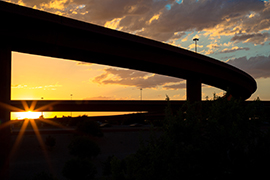- Slug: BC-CNS-Bridge Strong,570
- Photos available (thumbnails, captions below)
By BO TEFU
Cronkite News
WASHINGTON – Arizona bridges are among the most structurally sound in the nation, according to a recent national ranking that said just 2.6 percent of the state’s 8,154 bridges were structurally deficient in 2016.
The report last month by the American Road and Transport Builders Association said that was an improvement for the state from the 3.1 percent of deficient bridges recorded a year earlier, reflecting a drop in the number of problem bridges from 246 in 2015 to 214 in 2016.
It marks the fourth straight year that Arizona finished 48th among all 50 states and the District of Columbia on the bridges list, a fact that experts attribute to the age of the state and its infrastructure, its population density and, most importantly, its weather.
“Arizona is a young state, the key factors of the bridge deficiency are the age of the infrastructure,” said Alison Premo Black, chief economist for the ARTBA.
“The weather is consistent compared to Northeast states, where weather patterns and the age of the infrastructure tied together factor into deficiency,” Black said.
A spokesman for the Arizona Department of Transportation agreed that weather is a big advantage for the state.
“Mother Nature acts in a different way than in other parts of the country, which helps us benefit from the weather,” said Doug Nintzel, a spokesman for the department’s Metro Phoenix Region.
He also said that Arizona is “lucky not to have the oldest state in the country,” and noted that it has “fewer running waterways under the bridges,” which helps save wear and tear on spans.
But Nintzel said there are other factors behind the state’s “good track record,” including design and aggressive maintenance. He said the state invested $40 million in bridge improvements and reconstruction in one year.
“We are dedicated to safety and bridge preservation,” said Nintzel. “We are fortunate to live in the time of modern engineering.”
The report is based on annual inspection reports filed by the Federal Highway Administration, which conducts visual and construction inspections of bridges for indications that something may need improvement. Bridges are rated on a nine-point scale, with nine being “excellent” and anything under four considered deficient.
Experts cautioned that a bridge classified as deficient in the report does not mean that it is dangerous, just that it needs work. Nintzel said that bridge deficiency “should not imply that a bridge is unsafe to use.”
Black said the ranking also reflects the speed with which states are moving to fix problems, as much as it is a reflection of the condition of the bridges. In densely populated cities, “there’s constant movement” slowing down the pace for improvement, Black added.
“It does take time to improve projects,” she said. “The progress can be slow if states don’t find a way to deal with bridge deficiency.”
An official with the Arizona Trucking Association acknowledged the state’s good reputation with bridges, but said there is always room for improvement,
“Arizona is new compared to other states, but its infrastructure still needs attention,” said Bernie Gazdzik, a safety consultant for the truckers.
Gazdzik stressed the importance of sound bridges for commercial trucking, because “almost 99 percent of products come from trucks” making commercial trucking “the lifeline of America.”
“There is a large number of businesses getting products and services from the trucking industry,” Gazdzik said. “With good fridges and bridges, Arizona trucks can transport travel back and forth safely.”
^__=
Web links:
_ 2017 ARTBA bridge report: http://www.artba.org/deficient-bridge-report-home/
_ Arizona numbers: http://www.artba.org/deficient-bridge-state-page/?y=2016&state=AZ
^__=
Arizona is among the best states in the country when it comes to the strucutural integriity of its bridges, according to a recent national ranking. (Photo by Martin Ely/Creative Commons)
